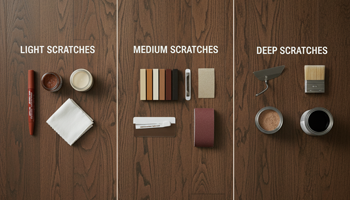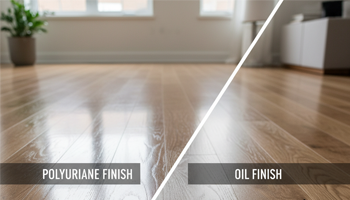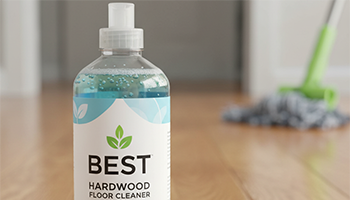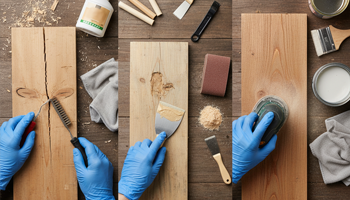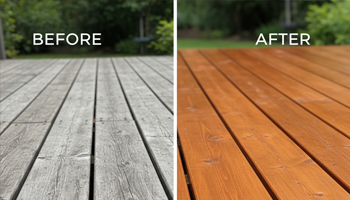Black Mold on Deck: Safe Removal & Prevention Methods
I’ve cleaned and inspected hundreds of decks in wet climates. Here’s the straight talk: about 60% of what homeowners call “black mold” on decks is actually surface mildew or tannin bleed—not toxic Stachybotrys chartarum. I once had a Portland client quoted $2,500 for “black mold remediation” when an afternoon and $30 of oxygen bleach did the trick. This guide shows you how to identify the problem, remove it safely (without chlorine bleach), and prevent it from coming back.
What Is Black Mold on Wood Decks?
Black staining on deck boards can come from several sources:
Stachybotrys chartarum vs. Surface Mildew
- True black mold (Stachybotrys chartarum): slimy black-green, clings even after scrubbing, thrives in persistently wet, cellulose-rich areas.
- Mildew/algae/soot/tannin bleed: wipes or scrubs off more easily; often gray, green, or brown.
- Quick field test: if a scrub brush + white vinegar lightens it in a minute or two, it’s likely not Stachybotrys. When it resists and feels slick/slimy, treat it as serious mold and follow the strict PPE steps below.
Visual Identification Guide
- Color/texture: slimy dark patches that persist after light scrubbing suggest true mold; powdery/film-like suggests mildew.
- Patterning: growth under fasteners or between boards often points to moisture traps, not necessarily toxic species.
- Smell: musty odor plus spongy wood can indicate deeper colonization.
Health Risks: Why Black Mold Is Dangerous
Respiratory Hazards and Symptoms
Exposure can trigger coughing, wheezing, throat/eye irritation, and asthma flares.
Who Is Most at Risk?
Children, older adults, people with asthma/COPD, and anyone who is immunocompromised are more vulnerable.
When to Call Professional Remediation
- Area >10 sq ft, persistent moisture, soft/rotting wood, or visible growth on structural members.
- Strong, musty odor that returns days after cleaning.
- Household members with significant respiratory issues.
Root Causes: Why Black Mold Grows on Decks
Moisture and Humidity Factors
Frequent rain, heavy dew, and high humidity saturate fibers and feed spores.
Poor Drainage and Standing Water
Clogged gaps, cupped boards, and planters without saucers cause small ponds—mold heaven.
Shade and Lack of Sunlight
Dense shade + little airflow = wet wood that never fully dries.
Insider insight: Most “it keeps coming back” cases I see are drainage and air circulation problems. Clean it 100 times; if you don’t fix moisture, it’s back in 2–3 months—guaranteed.
Safety Equipment: Essential PPE for Mold Removal
Respirators and Masks: N95 vs. P100
- N95 filters ≥95% of airborne particles—OK for light mildew work outdoors.
- P100/HEPA half-face respirator filters ≥99.97% and seals better—my choice for stubborn or slimy growth.
Protective Clothing and Gloves
Long sleeves, disposable coveralls if growth is heavy, and nitrile gloves (chemical-resistant).
Eye Protection Requirements
Closed goggles or sealed safety glasses to block splash and spores.
Inspection and Assessment Before Cleaning
Determining Extent of Infestation
Map all dark patches, undersides of stair treads, and board edges. Measure square footage.
Checking for Structural Damage
Probe suspicious boards near posts/ledger for softness. Replace rot before finishing.
Documenting the Mold Growth
Take photos before/after. If it returns, documentation helps diagnose hidden moisture.
Safe Removal Methods: Step-by-Step Protocols
Important: Work on a dry, mild day. Pre-rinse nearby plants and cover sensitive landscaping. Keep solutions off aluminum/untreated metals and rinse hardware promptly.
Method 1: White Vinegar Treatment (Mild Infestations)
- Mix: Use undiluted white distilled vinegar (5–6% acidity).
- Apply: Pump sprayer; saturate affected areas.
- Dwell: 10–15 minutes. Keep surfaces damp; re-mist as needed.
- Scrub: Medium-stiff nylon brush along the grain.
- Rinse: Garden hose, low pressure.
- When to use: Great for routine “black mold on deck” spots, fence rails, and balusters. Natural and plant-friendly when rinsed—ideal if you need a deck mold cleaner that won’t kill plants.
Method 2: Oxygen Bleach Solution (Moderate Cases)
- What it is: Sodium percarbonate—releases oxygen; safer on wood than chlorine.
- Mix: 1–2 cups per gallon of warm water (test 1 cup first).
- Apply: Flood the surface with a sprayer or watering can.
- Dwell: 10–20 minutes; don’t let it dry.
- Scrub: Nylon brush; lift residue from board grooves and under nail heads.
- Rinse: Thoroughly. Expect brightening as stains oxidize.
- Notes: Usually safe around plants at these dilutions—still, pre-soak landscaping and rinse after.
Method 3: TSP (Trisodium Phosphate) for Severe Mold
- Mix: ½ cup TSP + 1 gallon warm water (optionally add ½–1 cup oxygen bleach).
- Apply & Dwell: 10 minutes.
- Scrub: Firm nylon brush; reapply to stubborn spots.
- Rinse: Very well. Prevent runoff to beds/ponds; check local rules where phosphates are restricted.
- Use case: When vinegar/oxygen bleach won’t cut it and you’re dealing with slimy, embedded growth.
What NOT to Use: Dangerous Cleaning Methods
Why Chlorine Bleach Can Damage Wood
Chlorine bleach can degrade wood lignin, fade color irregularly, corrode fasteners, and scorch nearby plants. It often leaves spores in pores, so growth returns.
Pressure Washing Risks and Precautions
If you must:
- ≤1,200 PSI, 25°–40° tip, keep 12–18 in away.
- Move with the grain; never “dig” the fan edge.
- Limit to rinsing after chemical dwell; scrubbing cleans deeper with less damage.
Deep Cleaning Techniques for Embedded Mold
Scrubbing Strategies and Tools
Nylon deck brush on a pole; detail brush for edges, fasteners, and end grain. Replace worn brushes—rounded bristles smear instead of cutting.
Dwell Time Best Practices
Chemistry does the heavy lifting. Keep surfaces wet during dwell; re-mist every few minutes. Rushing = more scrubbing and fuzzed fibers.
Post-Removal Treatment: Killing Mold at the Root
Mildewcide Application
Apply an EPA-registered mildewcide labeled for exterior wood—follow label dwell and recoat times. This step is key if your deck black mold keeps coming back.
Wood Brightening After Mold Removal
Oxalic acid brightener after cleaning evens color and reduces tannin/rust marks. Neutralize/rinse per label before finishing.
Prevention Strategies: Long-Term Protection
Improving Deck Drainage
Open board gaps with a spacer card, add downspout extensions, and re-grade low spots. Move planters to stands with trays.
Sealing and Staining for Mold Resistance
Use a penetrating oil or waterborne stain with mildewcide; avoid film-formers that trap moisture. Recoat at the first sign of graying—not when growth is back.
Annual Maintenance Schedule
- Spring: Inspection + light wash (vinegar or oxygen bleach).
- Summer: Re-seal high-traffic areas if water no longer beads.
- Fall: Clear leaves, clean between boards, confirm drainage.
Personal note: I rarely see returns on decks that combine drainage fixes + penetrating stain with built-in mildewcide. Clean once, maintain lightly, and you’re set.
When DIY Isn’t Enough: Professional Remediation Signs
- Large area (>10 sq ft) or growth on framing/undersides that stays wet.
- Recurring slime within weeks despite good technique and prevention.
- Rot, soft boards, or compromised fasteners—replace first, then finish.
- Sensitive occupants (asthma, chemo, transplants). It’s not worth the risk.
What does professional deck mold removal cost? Basic clean/seal can range widely by region and deck size; specialized mold remediation with containment can be significantly more. Get written scopes that specify chemistry, dwell time, and protection for landscaping and runoff.
Decision Tree: DIY or Call a Pro?
• Yes → Any household members with asthma/immunocompromised?
• Yes → Call a pro.
• No → Try Vinegar or Oxygen Bleach protocol.
• No (larger than 10 sq ft) → Call a pro.
After cleaning: Does slime reappear within 2–3 weeks?
• Yes → Fix drainage/shade, apply mildewcide, consider pro assessment.
• No → Seal/stain and follow annual maintenance plan.
Quick Safety Checklist
- Respirator (P100 for severe growth; N95 for light mildew)
- Closed goggles
- Nitrile gloves & long sleeves/coveralls
- Nylon deck brush + detail brush
- Pump sprayer (dedicated for chemicals)
- White vinegar, oxygen bleach (sodium percarbonate), TSP (if allowed)
- Plastic sheeting to protect plants & metal
- Buckets, measuring scoop, clean water for rinse
- Trash bags for wipes/cloths
FAQs
How to safely remove black mold from deck without bleach?
Use undiluted white vinegar or oxygen bleach (1–2 cups/gal), dwell 10–20 minutes, scrub with nylon, and rinse. No chlorine bleach needed.
Is it safe to clean black mold on deck myself?
If it’s ≤10 sq ft and no high-risk occupants, yes—with proper PPE and ventilation. Otherwise, hire pros (I stick to this threshold in my own work).
Black mold on deck boards under nails—how do I remove it?
Flood with oxygen bleach, let it dwell, then detail scrub around fasteners. A small stiff nylon brush beats pressure washing here.
What deck mold cleaner won’t kill plants?
Vinegar and oxygen bleach at stated dilutions are plant-friendly when you pre-wet and rinse landscaping.
How long does deck black mold removal take?
A typical 200–300 sq ft deck with moderate growth: 2–4 hours including dwell, scrub, and rinse. Add a day for dry time before sealing.
Deck black mold keeps coming back—solutions?
Fix drainage and airflow, apply mildewcide, and switch to a penetrating stain. Maintenance washes each spring help.
Difference between mildew and black mold on a deck?
Mildew is a surface film that wipes/scrubs off; true black mold is slimy, embedded, and resists light cleaning.
Protective equipment needed for deck mold removal?
At minimum N95, goggles, gloves; for stubborn/slimy growth use a P100 respirator, long sleeves/coveralls.
You don’t need chlorine bleach—or a $2,500 “mold remediation” bill—to solve most “black mold on deck” problems. Start with correct identification, use vinegar or oxygen bleach with proper dwell and scrubbing, reserve TSP for severe cases, and lock in results with mildewcide and a penetrating stain. Most importantly, defeat moisture: open gaps, re-route water, and improve airflow. That’s how you remove it safely now and keep it gone.
Long-term prevention relies on routines from the Deck Care Encyclopedia, and cleaner comparisons from Best Deck Mildew Remover.
Cited Authorities
Currently viewing
Black Mold on Deck
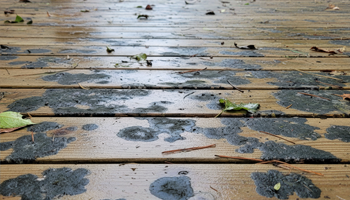
Repair Scratches in Hardwood Floors
How to Repair Scratches in Hardwood Floors: Complete Guide by Severity Level If you’re staring…
Refinishing Hardwood Floors
Sand & Refinish vs Screen & Recoat — Complete Comparison Guide If you’re weighing screen…
Polyurethane vs Oil Finish Floors
Durability & Maintenance Comparison If you’re comparing polyurethane vs oil finish for hardwood floors, you’re…
Best Hardwood Floor Cleaner
pH-Neutral & No-Residue Options TL;DR (buyer’s snapshot): For most homes, a pH-neutral hardwood floor cleaner…
Hardwood Floor Care Masterclass
Complete Guide by Wood Species & Finish If you want hardwood floor care by species…

